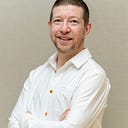Flights
A book of fragments
Kunicki: Water
Reading this haunting story of a young husband whose wife and child mysteriously vanish whilst on holiday on a Croatian island was the moment when Olga Tokarczuk’s prize-winning Flights sucked me in.

Ash Wednesday Feast
Stories don’t need to be linear, and Flights certaintly isn’t — just as life isn’t. Author Marlon James describes the book as working “like a dream does: with fragmentary trails that add up to a delightful reimagining of the novel.”
In one fragment, it takes Eryk — a character who goes on many journeys — ten years of circuitous travelling to get home. Just when he would think he’s heading home “suddenly some new opportunity would arise, more often than not in the exact opposite direction” and he comes to “the conclusion that the truest argument was an old one — the earth is round, let us not be too attached to directions.”
As another character explains, “constellation, not sequencing, carries truth.”
In Pursuit of Night
Reading one of the book’s fragments, I was drawn to compare the effect of the different short episodes with the experience of flicking between tv channels.
Travel Psychology (I)
In traditional novels, like traditional (eg Jungian) psychology, authors view and describe people as static, stable and fixed. Flights on the other hand is full of “people in transit,” people “moving from one place to another”. Perhaps this is because, as a woman giving a lecture in an airport argues, “if we wish to catalogue humankind in a convincing way, we can do so only by placing people in some sort of motion, moving from one place towards another.”
Her co-lecturer adds that “it is impossible to construct a consistent cause-and-effect course of argument or a narrative with events that succeed each other causistically and follow from each other.” To do so, he claims, would only be an approximation of life.
The first-person narrator stops listening though, complaining that “the lecture was too long. They ought to dispense this education in smaller doses.” Which it is tempting to take as an explanation of the structure of Flights itself.
Cabinet of Curiosities
“I’ve learned to write on trains and in hotels and waiting rooms. On the tray tables on planes. I take notes at lunch, under the table, or in the bathroom. I write in museum stairwells, in cafes, in the car on the shoulder of the motorway. I jot things down on scraps of paper, in notebooks, on postcards, on my other hand, on napkins, in the margins of books.”
Was this how Olga Tokarczuk wrote Flights?
Travel psychology (II)
Some of the episodes in the book appear to have “no consequences,” interrupting other episodes without becoming part of them. “They are self-contained occurences, each starting from scratch; each beginning and each end is absolute. Not a single episode is to be continued”.
Letters to the amputated leg
The novel contains the story of the Dutch anatomist Philip Verheyen, who dissected and drew pictures of his own amputated leg. He asks whether we are perhaps “condemned to wholeness, and every fragmentation, every quartering, will only be a pretence, will happen on the surface, underneath which, however, the plan remains intact, unalterable? Does even the smallest fragment still belong to the whole?”
Adam Mars-Jones in the LRB described Flights as “a passionate and enchantingly discursive plan for meaningful connectedness”.
Travel Tales
“Am I doing the right thing by telling stories? Wouldn’t it be better to fasten the mind with a clip, tighten the reins and express myself not by means of stories and histories, but with the simplicity of a lecture, where in sentence after sentence a single thought gets clarified, and then others are tacked onto it in the succeeding paragraphs?”
Lines, planes and bodies
“Moments, crumbs, fleeting configurations — no sooner have they come into existence than they fall to pieces. Life? There’s no such thing; I see lines, planes and bodies, and their transformation in time.”
Seeing is Knowing & Wax Model Collections
Some of the fragments connect with each other. Sometimes the connection is through a shared theme — travel, human anatomy. Alternatively, the connection can be through language, such as when two fragments start with the same first line: “Each of my pilgramages aims at some other pilgram.”
The Original and the Copy & Guidebooks
The more copies there are in the world, the greater the power of the original becomes. The more a painting is copied, the more people come to worship the original.
And yet describing is destroying. The descriptions in guidebooks destroy the real places. There is a “discrepancy between the pilgrims’ expectations” of Paris and what they find. The reality of the city bears “no resemblance to the city described in guidebooks, films and television.”
I’ve only read the first half of the novel. It’s brilliant, extraordinary.
